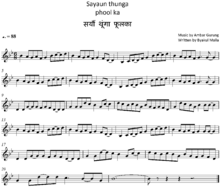Sayaun Thunga Phulka facts for kids
| English: Made of Hundreds of Flowers | |
|---|---|

Sheet music
|
|
| National anthem of | Nepal |
| Lyrics | Byakul Maila, 2007 |
| Music | Amber Gurung, 2007 |
| Adopted | 3 August 2007 |
"Sayaun Thunga Phool Ka" means "Made of Hundreds of Flowers". It is the official national anthem of Nepal. This song became Nepal's anthem on August 3, 2007. It was chosen during a special event at Singha Durbar by the speaker of the parliament, Subash Chandra Nembang. Before this, Nepal's anthem was "Shreeman Gambhir", which was used from 1962. But it was changed when Nepal's monarchy (rule by a king) ended.
The words for the anthem were written by a poet named Pradeep Kumar Rai, also known as Byakul Maila. The music was created by the famous Amber Gurung. The anthem's words are simple and beautiful. They talk about Nepal's freedom, its people's unity, and their bravery. It also praises Nepal's stunning nature, its progress, peace, and its many different cultures and animals. In 2016, the BBC said Nepal's anthem was one of the most amazing national anthems. They liked how different its music was from other anthems.
Contents
Anthem Lyrics and Meaning
The national anthem of Nepal tells a story about the country and its people. It uses a lot of imagery to show how special Nepal is.
| Nepali original | Transliteration | English translation |
|---|---|---|
|
𝄆 सयौं थुँगा फूलका हामी, एउटै माला नेपाली |
𝄆 Sayauṃ thuṁgā phūlakā hāmī, euṭai mālā Nepālī, |
𝄆 Woven from hundreds of flowers, we are one Nepali garland, |
What the Lyrics Mean
The anthem compares the people of Nepal to hundreds of flowers. These flowers are all different but are woven together to form one beautiful garland. This means that even though Nepalis come from many different backgrounds, they are all united as one nation.
The song also talks about Nepal being a free country. It says Nepal is spread out from its eastern border (Mechi) to its western border (Mahakali). It mentions the country's amazing natural beauty and wealth. It also honors the brave heroes who fought for Nepal's freedom. Their sacrifices made Nepal independent and strong.
The anthem describes Nepal as a land of wisdom and peace. It includes all parts of the country: the flat plains (Terai), the green hills (Pahad), and the tall mountains (Himal). It calls Nepal an unbreakable and beloved homeland.
Finally, the anthem celebrates Nepal's rich diversity. It mentions the many different groups of people, languages, religions, and cultures. It says Nepal is a nation that is always moving forward and wishes it long life and success.
History of the Anthem
Nepal's journey to its current national anthem involved important changes.
Choosing a New Anthem
On May 19, 2006, the interim House of Representatives made a big decision. They decided to stop using the old national anthem. A special team was then formed to find a new song. This team was called the National Anthem Selection Task Team.
Many people from all over Nepal sent in their songs. In total, 1,272 songs were submitted! On November 30, 2006, the team chose the song written by Byakul Maila. The new anthem was officially approved on April 20, 2007.
Official Adoption
A few months later, on August 3, 2007, "Sayaun Thunga Phulka" was officially declared Nepal's national anthem. This was done by the House of Representatives, making it the country's official song.
How to Show Respect
There are rules about how to show respect for the national anthem.
Anthem Protocol
When the national anthem is played in public, everyone must stand. This shows respect for the country and its flag. Radio and television stations in Nepal also play the anthem. They broadcast it when they start their programs and when they finish for the day. This reminds everyone of the country's pride and unity.
See also
 In Spanish: Sayaun Thunga Phool Ka para niños
In Spanish: Sayaun Thunga Phool Ka para niños
- "Shreeman Gambhir", the national anthem of the Kingdom of Nepal

